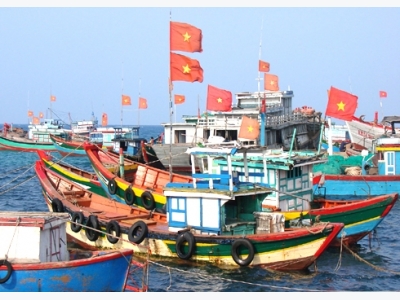Fishing quotas to be set at local level

Given the declining status of fisheries, especially in coastal waters, and the use of destructive fishing methods, the Ministry of Agriculture and Rural Development is taking steps to ensure sustainable exploitation. Deputy Minister Vũ Văn Tám talks about this plan with Vietnam News Agency.
The large number of fishing vessels has led to great exploitation of our fisheries resources. What do you think?
It’s true that the number of fishing vessels is relatively large, while resources are declining. Therefore, it is necessary that we conduct a total re-planning, making sure the number of offshore fishing vessels does not exceed 30,000 vessels. Vessels should also be upgraded so that they can work more effectively.
On the other hand, it is necessary to reduce the number of inshore fishing boats. The ministry will issue regulations for management in the future, for instance, using different colours for onshore and offshore fishing vessels.
Fishing surveillance teams will be set up in 28 coastal provinces to enhance supervision and management of the vessels. We will also decentralise management to local agencies in exploiting fishery resources.
But the most important thing still is to raise the awareness of fishermen. As the sanctions and administrative measures are still limited, the most important is for them to understand that they should take into account a sustainable future for their sector.
Therefore, a responsible fishery industry must be established, based on a baseline survey, whereby appropriate regulation of catches is made. These contents have been incorporated into the Fisheries Law aimed at exploiting and developing the sustainable fisheries.
Could you elaborate on the allocation of quotas for localities?
This is a method of scientific management used around the world. We are moving towards this type of management. That is to say, we have to investigate the fisheries resources, know the maximum exploitation that can be allowed. Based on these factors, the ministry will make planning for the fishery industry, such as which sea areas can be exploited, issuing licenses to vessels, and other scientific measures to stabilise catches and protect resources.
This is an important solution. In the Fisheries Law, this issue will be made firm and the quota allocated to localities will be calculated based on aquatic surveys. Simultaneously, issuing licenses to new fishing vessels as well as controlling the whole chain of fisheries aims at the traceability of products to meet the requirements of importers.
Currently, the number of trawlers is about 12,000. It is planned to reduce the number. How will this be done?
In the revised version of Decree 67, from the year 2018, no new fishing vessels will be built. But vessels can be upgraded and changed or repaired if owners want to shift from trawlers to purse seiners. The total number of fishing vessels will still be the same..
How about the timeline for reducing onshore fishing vessels?
The Fisheries Law will decentralise the management of coastal vessels as well as exploit resources for localities.
Based on this, localities can decide whether to increase or cut down the number of vessels, taking into account factors such as fisheries reserves, marine resources and resource protection. These decisions have to be made by local authorities in coordination with the Government and in the availability of technical solutions to protect the spawning grounds, marine conservation zones, ecosystems.
The protection of fishery resources is important. So, when decentralising management, it’s totally dependent on local authorities. If the resources are well managed, the number of fishing vessels can increase
Related news
 Can Tho, Brazil’s Maranhao state partner in rice production, aquaculture
Can Tho, Brazil’s Maranhao state partner in rice production, aquaculture Authorities of the Mekong city of Can Tho and Brazil’s Maranhao state on October 26 signed a letter of intent to set up friendship and cooperation in rice
 How to tap domestic seafood market potential
How to tap domestic seafood market potential To tap the great potential of the domestic seafood market, the state needs to apply incentive policies to assist seafood-processing facilities in promoting sale
 New model predicts precise locations of ocean hotspots
New model predicts precise locations of ocean hotspots The model is designed to predict the geographic distribution of copepods such as this one, which was collected near Monterey Bay.